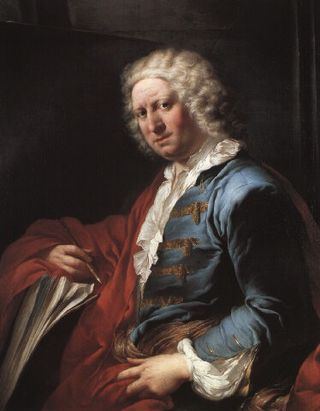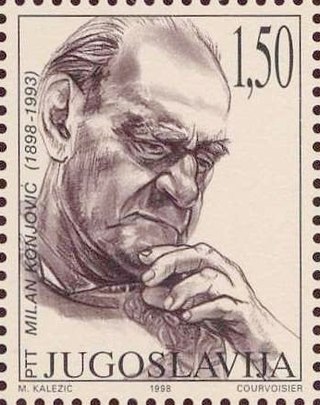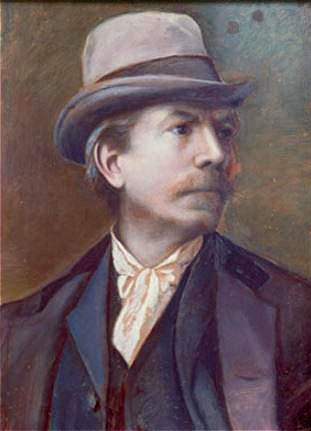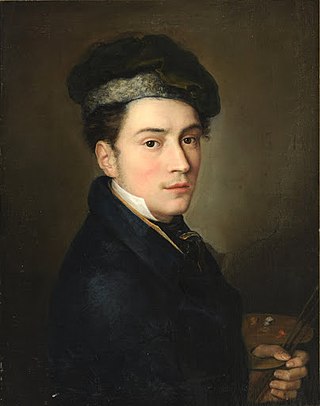This article needs additional citations for verification .(February 2024) |

Aldo Raimondi (Rome, 1902 - Milan, 1997), was an Italian painter. [1]
This article needs additional citations for verification .(February 2024) |

Aldo Raimondi (Rome, 1902 - Milan, 1997), was an Italian painter. [1]
Born in Rome in 1902, Raimondi began his artistic career there in the studio of Giuseppe Signorini. He majored in architecture at the Academy of Fine Arts at the age of 22. Between 1925 and 1926 he lived in Milan, where he served in the Italian military; while there, he painted a fresco for a barracks, and restored some of the rooms of the Palazzo Cusani, home of the Command of the Army Corps.
Raimondi moved to Parma in 1926, and began to teach in the local Art Institute: there he inserted himself into a difficult environment without much effort, and was quickly befriended by the natives for his extraordinary dedication to his craft and the eye-catching qualities of his character. In Parma, he was commissioned by the mayor to paint some watercolors of the view over the old city, still visible today in the Town Hall, which are proof of his skill as a landscape artist; Raimondi would receive other such commissions both in Italy and abroad later on. In Parma in 1930 he organized his first of many solo exhibitions, both in Italy and abroad. From 1938-40 he replaced Achille Beltrame as the illustrator of "Domenica del Corriere," and later was called to illustrate "The People of Turin."
Specializing in watercolor painting, an exclusive piece of his repertoire, in 1939 he was appointed a professor of watercolors at the Academy of Brera, a chair he left immediately after the war to devote himself full-time to making films. Later he painted landscapes, animals, flowers and many portraits, including those of the Popes Pius XII, John XXIII (1958) and Pope Paul VI (1966). He also produced some windows for the Seminary of Monza, for the parish of Menaggio in Como, and the church of San Simpliciano in Milan.

Antonio del Pollaiuolo, also known as Antonio di Jacopo Pollaiuolo or Antonio Pollaiuolo, was an Italian Renaissance painter, sculptor, engraver, and goldsmith, who made important works in all these media, as well as designing works in others, for example vestments, metal embroidery being a medium he worked in at the start of his career.

Giovanni Paolo, also known as Gian Paolo Panini or Pannini, was an Italian painter and architect who worked in Rome and is primarily known as one of the vedutisti. As a painter, Panini is best known for his vistas of Rome, in which he took a particular interest in the city's antiquities. Among his most famous works are his view of the interior of the Pantheon, and his vedute—paintings of picture galleries containing views of Rome. Most of his works, especially those of ruins, have a fanciful and unreal embellishment characteristic of capriccio themes. In this they resemble the capricci of Marco Ricci. Panini also painted portraits, including one of Pope Benedict XIV.

Milan Konjović was a Serbian painter whose works can be divided into six periods of artistic style. He studied in many countries abroad and lived in Paris from 1924 to 1932. His long life's work earned him many recognitions as well as a place in the Serbian Academy of Sciences and Arts.

Sebastiano Ricci was an Italian painter of the late Baroque school of Venice. About the same age as Piazzetta, and an elder contemporary of Tiepolo, he represents a late version of the vigorous and luminous Cortonesque style of grand manner fresco painting.
Giovanni Buralli, known as John of Parma, was an Italian Franciscan friar, who served as one of the first Ministers General of the Order of Friars Minor (1247–1257). He was also a noted theologian of the period.

Sylvester Feodosiyevich Shchedrin was a Russian landscape painter.

Francesco Londonio was an Italian painter, engraver, and scenographer, active mainly in Milan in a late-Baroque or Rococo style.

Guglielmo de Sanctis was an Italian painter.

Michele Cascella was an Italian artist. Primarily known for his oil paintings and watercolours, he also worked in ceramics, lithography, and textiles. He exhibited regularly at the Venice Biennale from 1924 until 1942, and his works are owned by major museums in Italy and Europe, including Victoria and Albert Museum in London, Galerie nationale du Jeu de Paume in Paris, and Galleria Nazionale d'Arte Moderna in Rome.

Tommaso Minardi was an Italian painter and author on art theory, active in Faenza, Rome, Perugia, and other towns. He painted in styles that transitioned from Neoclassicism to Romanticism.

Cherubino Cornienti was an Italian painter, active in a Romantic style mainly in Northern Italy.

Antonio Zona was an Italian painter, active in a style fusing Neoclassicism and Romantic style.

Giovanni Piancastelli was an Italian painter and architect.

Gustavo Mancinelli was an Italian painter in several genres; including landscapes, historical scenes, and portraits.

Carlo Raimondi was an Italian engraver and painter, active mainly at Parma.

Giuseppe Pietro Bagetti was an Italian civil and military architect, as well as painter. He painted landscapes and battle paintings.

The papal nobility are the aristocracy of the Holy See, composed of persons holding titles bestowed by the Pope. From the Middle Ages into the nineteenth century, the papacy held direct temporal power in the Papal States, and many titles of papal nobility were derived from fiefs with territorial privileges attached. During this time, the Pope also bestowed ancient civic titles such as patrician. Today, the Pope still exercises authority to grant titles with territorial designations, although these are purely nominal and the privileges enjoyed by the holders pertain to styles of address and heraldry. Additionally, the Pope grants personal and familial titles that carry no territorial designation. Their titles being merely honorific, the modern papal nobility includes descendants of ancient Roman families as well as notable Catholics from many countries. All pontifical noble titles are within the personal gift of the pontiff, and are not recorded in the Official Acts of the Holy See.

Luigi Marchesi was an Italian painter who specialized in architectural and interior scenes.

Pietro Gagliardi was an Italian painter and architect, who decorated many churches and palaces in Rome and throughout Italy.

Leopoldo Metlicovitz was an Italian painter, illustrator and poster designer.